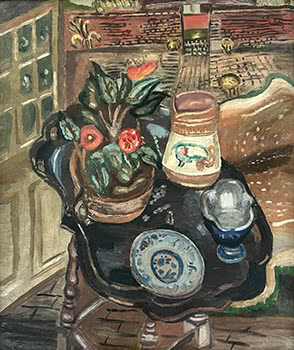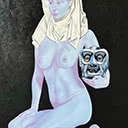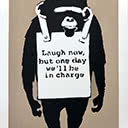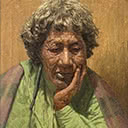Still Life
66.2 x 55.8 cm
PROVENANCE Private Collection St George's Gallery, London, England Lucy C Wertheim, London, England Mr & Mrs Philippe Garner, executors of Lucy C Wertheim's Estate, London, England, 1971 Private Collection, Auckland Private Collection, Christchurch Literature Frances Hodgkins database number FH0895 Situating still life subjects in the outdoors was popular amongst the English artists of the inter-war period. Winifred and Ben Nicholson, David Jones, Paul Nash, Christopher Wood and Cedric Morris all painted versions of this leitmotif. Frances Hodgkins made it her specialty, often combining flowers and fruit with interesting ceramics. Of her entire output of paintings, nearly 100 are "open air still lifes".
Frequenting antique shops and stalls at fairs, she collected old or decorative pottery to be included in her compositions as props. These wares sometimes became her focus as in Spanish Jars, Red Jugs, Phoenician Pottery and Gourds, and the lithograph she was commissioned to make in 1937, Arrangement of Jugs. Some appear in Cedric Morris's 1917 portrait which shows her seated, dressed in lilac, and reading a book, with a kitchen dresser laden with dishes and jugs beside her. Her love of decorative arts is evident in this still life from 1930 where a painted Italian jug, a blue-and-white oriental porcelain dish and a curved blue glazed sweet bowl are grouped with a flowering begonia in its terracotta pot. To create equilibrium, these four individually lively objects are assigned to the corners of a Japanese black lacquerware tray. This is tipped up towards the viewer so that the supporting shiny surface, sparkling with inlaid mother-of-pearl shell decoration at the centre, can be admired.
The tea tray sits on a four-legged English oak stool, its turned legs perched on stone or brick paving. Although the domestic realm and outdoor scene are merged, to demarcate the indoors from the garden beyond she has used the device of a deerskin floor rug lined with green baize. Her fluent brushwork defines the edge of each form in the composition. The setting is likely to be Pound Farm in Higham, Suffolk, the seventeenth- century house with a paved and walled garden which had been leased by her friends Cedric Morris and Arthur Lett-Haines since early 1929. Its National Trust listing records that one of the old half-glazed doors to the cross wing survives, and Hodgkins has included this notable feature on the left of her composition. Its expanse of brown panels and small-paned glass acts as a repoussoir device (like a stage flat in the theatre) to lead the eye into the background. She denotes the hand-blown crown glass in the top half of the door in summary fashion, its characteristic bullseye shape merely suggested in the top right four panes.
Morris and Lett-Haines frequently hosted Hodgkins as a houseguest, picking her up in their motorcar from nearby Flatford Mill, (where they had arranged for her to have free use of a studio), or from her lodgings at the White Horse Hotel at East Bergholt. She wrote to Lucy Wertheim (1883-1971), a collector and soon-to- be gallerist, "[I] am glad of the quiet & deep peace of this place but anywhere in England is unsympathetic & difficult for an artist - The sea of green everywhere - The red brick - & the stoney paths & the stoney stares of the villagers - Oh Lord! But the big free Studio at the Mill is a real catch." As publicity for a solo exhibition at the St George's Gallery in Hanover Square, London to be held in the autumn of 1930, she was photographed in the Flatford studio, fashionably dressed in a cloche hat and heeled shoes, facing away from the camera towards framed examples of her work on the back wall. She had signed a contract with owner Arthur Howell making him the sole agent for watercolours for three years and giving him right of first refusal on her oils. In May, Hodgkins posted off the last of her Still Life series to him, ahead of the opening in early October. The exhibition was greatly acclaimed, with the reviewer for The Times enthusiastic: "The exhibition ... ought to confirm and extend the reputation of one of our most original artists." At the age of 61, Hodgkins was finally an overnight success. Howell later documented this successful period in the artist's life in his book Four Vital Years.
Also in October 1930, Lucy Wertheim, whom Hodgkins had met in Manchester in 1926, opened her eponymous gallery in Burlington Gardens in Mayfair. Despite the difficulties of the Great Depression, she went on to open galleries in Brighton and Manchester as well, representing Hodgkins, Cedric Morris, Christopher Wood and others of their ilk until 1939 when the advent of the Second World War forced her to close. Married to a Belgian shipping magnate, Wertheim collected voraciously, both endowing the Towner Gallery in Eastbourne, and donating 183 works to the Auckland Art Gallery in 1948. The Wertheim collection toured New Zealand galleries in 1952, introducing an audience in Hodgkins' homeland to the British modernism which was the context for understanding her work.
LINDA TYLER
EXHIBITED 1947 Pictures by Frances Hodgkins, Manchester Art Gallery, England 1948 An Exhibition of Pictures by Frances Hodgkins, Sponsored by the Isle of Purbeck Arts Club in Association with the Arts Council of Great Britain 1953 Famous British women artists: an exhibition of paintings and drawings in the Graves Art Gallery, Sheffield 1989 Frances Hodgkins, Works from Private Collections: An Exhibition Held to Celebrate the Opening of the New Store and Gallery, Kirkcaldie & Stains Limited Wellington





